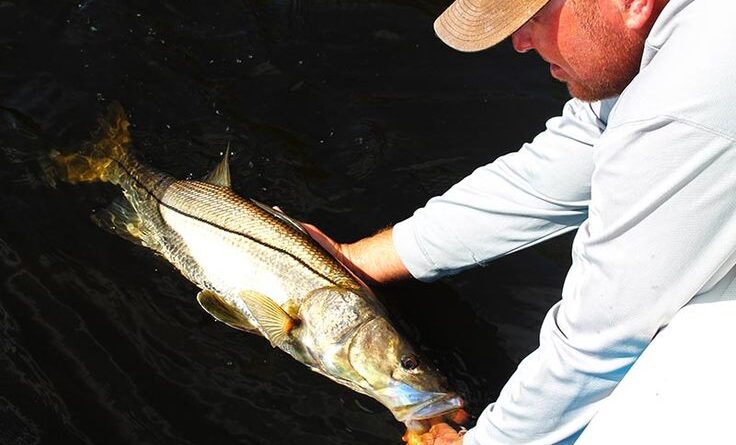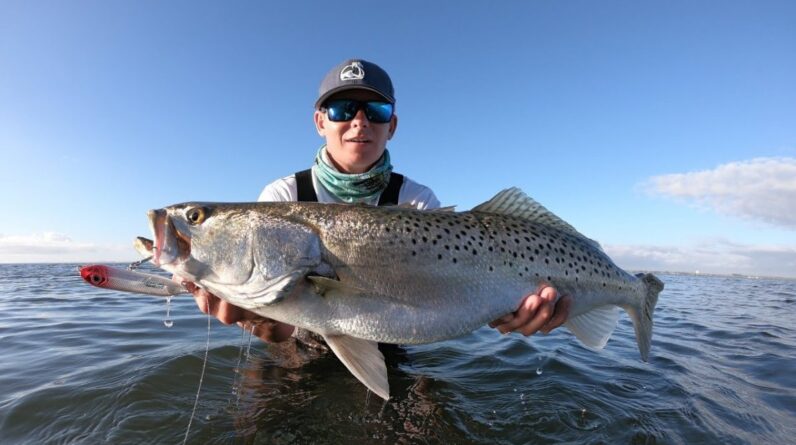Welcome to the exciting world of surf fishing! If you’ve ever dreamed of casting your line into the crashing waves and reeling in the catch of the day, you’re in the right place. The benefits of surf fishing are crystal clear. Beaches are typically readily accessible, minimal equipment and experience are required, and the potential rewards are substantial.
In this beginner’s guide, we’ll take you through the essential techniques, equipment, best time and spot, and tips you need to embark on your surf fishing adventure. Whether you’re casting from the beach for the first time or looking to improve your skills, we’ve got you covered. Let’s dive in and discover the joys of surf fishing!

Short Summary:
- Start with the Basics: Learn the essential surf fishing techniques, even if you’re a total beginner.
- Get the Right Gear: Find out what fishing equipment you need, like rods and reels, to start.
- Tips and Tricks: Discover helpful tips and tricks for surf fishing to improve your fishing experience.
- Timing Matters: Understand when and where to fish for the best chances of success.
- An Adventure for Beginners: Begin your surf fishing adventure with our easy-to-follow guide.
What is Surf Fishing?
Surf fishing is a popular form of recreational fishing that occurs along the shoreline of oceans, seas, or large bodies of water. It involves casting bait or lures from the beach or a fishing platform, such as a jetty or pier, into the surf zone where the waves break.
The primary goal of surf fishing is to catch fish species that are found in the surf, often including species like surfperch, striped bass, flounder, redfish, and various types of saltwater panfish.
What Do You Need Exactly for Surf Fishing?
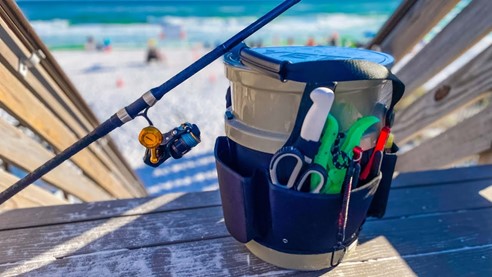
Before we delve into advice on the best tackle and rigs to use, let’s run through a brief checklist of the essentials you’ll need for your surf fishing expedition:
- Sand spikes and Rubber mallets (To make it easier to insert them into the sand)
- Fishing reels and rods
- Live bait, frozen bait, cut bait, and a selection of lures.
- Lines, hooks, leaders, and tackle
- Surf fishing rigs
- A knife
- Pliers
- A bait bucket with an aerator
- A wet towel
- First aid kit
- Sunscreen and Sunglasses
- Umbrella, Rain jacket and rain gear
Equipment: Gear and more
Surfcasting is easy and doesn’t need fancy equipment or lots of preparation. Let’s talk about the rods, reels, rigs, and bait you should bring to the beach.
Surf Fishing Reels
Surf fishing reels are available in various shapes and sizes. Many individuals choose spinning reels due to their ease of use, and they can be paired with shorter rods. Nevertheless, conventional reels also perform well, especially when you are going to catch larger fish that demand increased strength and power.
Moreover, the most commonly used reels are in the 6000 – 8000 size range. Choose a spinning reel in the 6000-8000 size range that can hold at least 500 yards of 25lb braid. With these, you can catch bigger species like Snook, Bull Redfish, Sharks, and Bluefish.
Surf Fishing Rods
One of the first things you’ll see with surf fishing rods is that they are longer than regular ones used in saltwater. This extra length is needed to go extra into the troughs beyond the breaking waves. The length of the rod can differ between 7 – 15 feet.
An 8-foot surf rod is suitable for calm waters, but if the conditions are rough, opt for a rod that’s at least 10 feet long. Unless you’re fishing in a location where the surf is very big, a medium-heavy 8 to 12-foot rod with moderate action is the best choice. Shorter rods are designed for shorter casts and smaller fish.
Fishing Lines
Both monofilament and braided fishing lines are the best choices depending on the species you are after and fishing conditions. Monofilament is more flexible than braid. You can use 5–10 lb mono for smaller setups, 15 lb for medium reels, and 15–30 lb for large reels and long rods.
The braided fishing line is lighter, allowing for longer casts. You can use up to 30 lb braid for smaller and medium reels and up to 50 lb for larger setups.
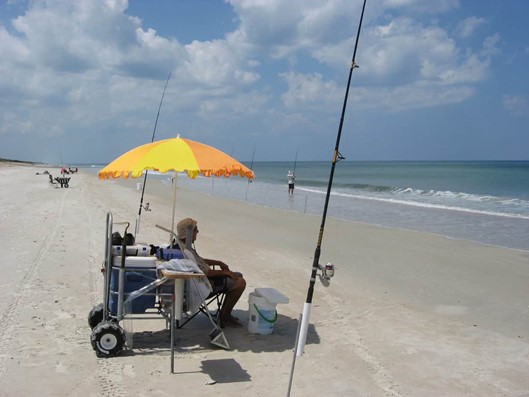
The Best Bait for Surf Fishing
Live bait is the top choice for surf casting. Your choice depends on your fishing location. Generally, live shrimp and squid are reliable options, and you can also have success with finger mullet, minnows, and herring.
Cut bait like squid strips, mullet strips, and shrimp work well, especially for Sharks and Flounder. Other good options include sand crabs, clams, greenbacks, and sandworms.
While artificial lures can be useful in a pinch, many surf fishermen prefer live bait for its higher productivity. If you want to avoid the hassle of keeping bait alive, you can opt for jigs, soft plastic baits, spoons, or topwater poppers. Soft plastics are particularly useful because they emit a strong scent that attracts predators.
Surf Fishing Rigs
Surf fishing rigs refer to various setups or arrangements of hooks, lines, and other components anglers use to catch fish. The most popular rig is the fish-finder rig, which you can use in most conditions and whatever species you would like to target.
Another popular rig is the high-low rig. This is the preferred choice for anglers using live bait, and it’s advantageous because it allows you to have two pieces of live bait in the water simultaneously. More options include pompano rigs, fireball rigs, and ready rigs.
The Best Time for Surf Fishing
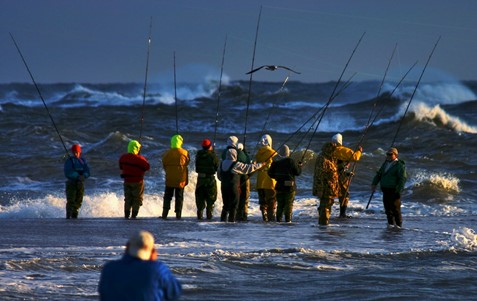
Well, there is no specific answer to this question. Surf fishing typically sees the best results during incoming tides in low-light conditions, such as sunrise and sunset, but there are no strict rules. Getting ideal fishing conditions is tough, but knowing when fish are likely to bite can make a big difference between a successful or disappointing day of surf fishing. While each angler has their own views and experiences on the best conditions, here are some general tips most agree with:
During high tide, especially at dawn or dusk, you can expect more fish to come in for feeding due to the increased water in your fishing area. However, some species may favor low tide. It means you can head out during the early morning or a few hours before sunset.
Furthermore, cloudy and rainy weather can reduce the visibility of shadows from your line, making your bait more enticing to fish. However, keep an eye on the weather and always be ready to find shelter if there’s a thunderstorm or unexpected bad weather, such as high winds causing hazardous waves and conditions.
The Best Spot for Surf Fishing
Before your first cast, it’s essential to conduct a scouting mission known as “reading the beach.” This involves identifying the prime spots near the shore where fish are likely to hide. If you find out these areas, you can significantly increase your chances of catching. These areas include sandbars, troughs, points, seams, covers, and other structures like jetties and piers.
You can find sandbars where the water waves break as they come near the shore, constantly changing with weather and conditions. The water between the shoreline and the sandbars is called trough. Most fish will likely have to hang out during high tide here. However, you can easily find these areas when the water pulls back during low tide.
Moreover, fish tend to favor deeper waters during high tide, whereas, during low tide, they are more likely to be found in shallower areas. Understanding the tide schedule for your fishing location can assist you in selecting the appropriate spot and time to cast your line.
What Species Can You Catch in Surf Fishing?

Surf fishing offers a variety of species. Each region has its own typical catches, so the type of fish you’ll catch depends on your location and the time of year.
Some of the most common species you can find along the East Coast include Striped Bass, Croaker, Bluefish, Tautog, and Smelt. Along the Gulf Coast, you can catch Snook, Redfish, Spotted Seatrout, Pompano, and Mackerel. In some regions, you can hook into a tarpon, Cobia, Sheepshead, Barracuda, Ladyfish, and Jack Crevalle.
On the West Coast, you’ll have the opportunity to catch California Corbina, Halibut, Rockfish, Mackerel, Surfperch, and various other species. Sharks are also a popular target, and you can encounter different types of species no matter where you cast your line. As you can see, shore fishing offers plenty of exciting opportunities. While you may not always target game fish, there’s an abundance of fish species to keep you engaged.
Best Techniques for Surf Fishing

Firstly, let’s talk about what makes surf casting unique compared to regular casting. While the basics remain the same, the main difference lies in the length of your cast. You will need longer overhead casts to reach the fish, which often hide between troughs and around sandbars. Below are some tips and tricks that can improve your catching:
When it’s time for actual surf fishing, begin with the proper setup. First, choose a suitable location. Seek out areas with ample sand and fewer rocks to prevent line tangling. Second, once you’ve found a good spot, set up your fishing rod and reel. Make sure to attach weights to your line approximately 18 inches above the bait. It will help keep your bait in place.
After you’ve completed your setup, you can use various techniques. A commonly used method is to cast your line into the water and wait for a fish to bite. Alternatively, you can try bottom fishing, allowing your bait to sink to the water’s bottom and patiently waiting for a fish to come by and take the bait. Regardless of your chosen method, remember to be patient; fishing often requires waiting for a fish to bite, which can take some time.
We strongly recommend using two fishing poles per angler for surf fishing. This approach enables you to target various species without the challenge of handling many rods. Standing between both poles allows you to respond quickly when a fish bites, greatly enhancing your chances of success.
Prepare one pole with a heavier setup for cutting bait and the other with a lighter setup for shrimp or squid. The heavier rig is ideal for larger species, while the lighter rig is perfect for smaller ones.
Surf Fishing for Beginners: Frequently Asked Questions (FAQs)
You’ll need several essentials for surf fishing, including fishing rods and reels, live or cut bait, lines, hooks, leaders, tackle, sand spikes, a rubber mallet, pliers, a bait bucket with an aerator, a knife, a wet towel, first aid kit, sunscreen, sunglasses, umbrella, rain jacket, and rain gear.
The species you can catch in surf fishing depends on your location and the time of year. Common species include Striped Bass, Croaker, Bluefish, Tautog, Snook, Redfish, Spotted Seatrout, Pompano, Mackerel, California Corbina, Halibut, Rockfish, Surfperch, and various types of sharks.
Surf fishing reels come in different shapes and sizes, with spinning reels and conventional reels being popular choices. Most anglers often prefer spinning reels for their ease of use, while conventional reels offer more strength and power, ideal for larger fish.
A typical range for surf fishing reels is 6000-8000 size, and they should hold a minimum of 500 yards of 25lb braid. These sizes are suitable for targeting larger species like Snook, Bull Redfish, Sharks, and Bluefish.
Safety is paramount in surf fishing. Beginners should know local regulations, be cautious of rough surf conditions, and monitor changing weather patterns. It’s essential to stay hydrated, wear appropriate sun protection, and have a basic understanding of water safety.
To enhance your surf fishing skills, practice casting techniques, read the beach to identify prime fishing spots, and learn from experienced anglers. Patience is key, as fishing often requires waiting for fish to bite.
Conclusion
In conclusion, surf fishing offers an exciting and accessible way to enjoy the thrill of catching fish along the shoreline. It is also a relatively easy way to get started fishing, as you do not need a lot of expensive equipment. With the right techniques, equipment, and a bit of patience, beginners can dive into this rewarding hobby.
This guide has covered the essential techniques, equipment, tips, and information needed to start your surf fishing journey. From choosing the right gear to understanding the best time and spot for fishing, we’ve provided you with a comprehensive overview of this rewarding outdoor activity. Whether you’re casting from the beach for the first time or seeking to improve your skills, the world of surf fishing is waiting for you to explore. So, grab your gear, head to the beach, and discover the joys of surf fishing today!




